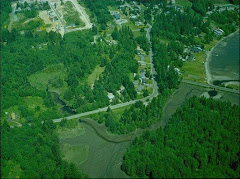“Why have we been working on these symptoms for so long and so hard; and even with so many successful programs, why have we seen too little fundamental change?” asks Peter Block in his book Community; The Structure of Belonging. His answer: “a breakdown of community.” When this idea is applied to salmon recovery and stream restoration, it sheds some light on our ongoing struggle to find effective and long lasting solutions.
The question of what causes the deterioration of our streams and rivers is a complex question indeed, but one that is worth some heavy consideration. We can identify the physical threats such as dams, culverts, clear cutting, erosion and so on, and consequently we have put in place regulations such as permits and fines. However, the conditions of our streams and salmon populations continue to decline. How is it that even though we know that these and similar degrading activities greatly impact watersheds, they continue to happen anyway. It’s not that the people who build dams, overgraze riparian areas, or clear cut in sensitive drainages have malicious intentions to destroy streams and deserve all the blame. Rather it seems like the root of the problem is that as a society we allow this to happen. Why? Perhaps it is because of this “breakdown of community” that Block suggests. We have lost touch with our rivers and streams to such an extent that these violations have become normalized. Not on purpose of course, but as a result of our overbooked lives and the shortsighted nature of our culture. Majority of us have forgotten the services these streams provide and how important they are for the health of the surrounding communities, humans included.
It seems like if we really want to get in front of these destructive patterns, we need to begin to restore our personal relationships with our watersheds. When people have a strong connection to an area, it seems like they are more likely to ensure that it is properly taken care of. Finding ways to reconnect communities to the local streams and rivers becomes the other component to the physical environmental restoration projects. If the restoration community can find ways to validate and help cultivate these relationships, we will then start to get ahead in the protection and preservation of our watersheds.
Block, P. 2008. Community; The Structure of Belonging. Berrett-Koehler Publishers, Inc., CA. pg.34
Friday, February 19, 2010
Wednesday, February 10, 2010
What is the Carpenter Creek Community Mapping Project?
As the human population booms in the Puget Sound area and the salmon numbers decline, it is becoming increasingly more vital that restoration projects are implemented in ways that are conducive to both the ecosystems and local communities. Surrounding communities are likely to be affected by stream restoration and habitat improvement projects, but often have a very limited role in their creation. The absence of meaningful public participation and engagement can divide the community, delay the project, increase the expense, and result in a plan that does not reflect the values of the community. The history and local knowledge found within a watershed can be used as a valuable tool to connect people to place, give voice to the community, and provide important information for restoration efforts. The Carpenter Creek Community Mapping Project is an attempt to weave together science, history and local knowledge within the watershed.
The goal of this project is to have community members collect historical data and local knowledge of the Carpenter Creek watershed. Volunteers will be asked to conduct interviews with residents, search libraries and museums for relevant information, including maps and photos, and to inquire with fellow citizens the reasons they value Carpenter Creek. The data will be used to create an interactive web-based map that depicts the community’s historical and current relationship with the drainage. Each piece of information will be linked to its relevant place on the map helping to create a more complete story of the watershed.
It is anticipated that by doing this project we can gain a better understanding of how the valuable knowledge found within local communities can be used to help strengthen peoples’ ties to their watershed and contribute to the creation of effective restoration projects. The Carpenter Creek Community Mapping Project will serve as a case study to help answer some of these questions and will hopefully inspire us to look closely at our relationships with our local rivers and streams.
The goal of this project is to have community members collect historical data and local knowledge of the Carpenter Creek watershed. Volunteers will be asked to conduct interviews with residents, search libraries and museums for relevant information, including maps and photos, and to inquire with fellow citizens the reasons they value Carpenter Creek. The data will be used to create an interactive web-based map that depicts the community’s historical and current relationship with the drainage. Each piece of information will be linked to its relevant place on the map helping to create a more complete story of the watershed.
It is anticipated that by doing this project we can gain a better understanding of how the valuable knowledge found within local communities can be used to help strengthen peoples’ ties to their watershed and contribute to the creation of effective restoration projects. The Carpenter Creek Community Mapping Project will serve as a case study to help answer some of these questions and will hopefully inspire us to look closely at our relationships with our local rivers and streams.
Subscribe to:
Posts (Atom)
